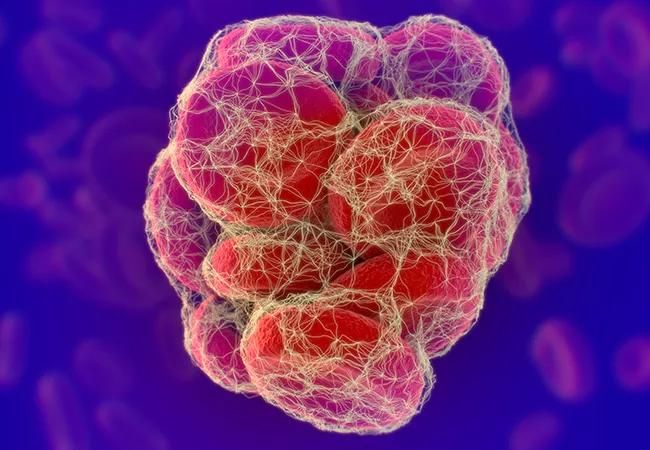Toward an evidence-based approach

By Alana Nevares, MD, and Alexandra Villa-Forte, MD, MPH
Advertisement
Cleveland Clinic is a non-profit academic medical center. Advertising on our site helps support our mission. We do not endorse non-Cleveland Clinic products or services. Policy
Venous thrombotic events (VTE) can manifest as recurrent disease associated with significant morbidity and mortality. Patients with granulomatosis with polyangiitis (GPA) have a higher incidence of VTE, but the rate of first VTE recurrence has not been studied. As rheumatologists, we often treat these patients in collaboration with vascular medicine or hematology without scientific data to support decision making. As an initial step toward an evidence-based approach to anticoagulation therapy for our patients, we aimed to first determine the incidence rate of first VTE recurrence in patients with GPA.
Anticoagulation therapy in the general population aims to prevent recurrences. Standardized guidelines from groups like the American College of Chest Physicians address the duration of anticoagulation for pulmonary embolism, proximal provoked and unprovoked deep vein thrombosis (DVT), and distal DVT. Multivariable risk models have been designed to predict the rate of recurrence of unprovoked VTE in the general population.
Merkel et al. first reported a high incidence of VTE in patients with GPA (7 per 100 person-years; 95% CI 4 to 11.4) in a large prospective study in 2005. The study found a higher incidence rate of first VTE as compared with the general male population and with patients with systemic lupus and rheumatoid arthritis (Table). This study was a turning point in the daily care of GPA patients as it recognized VTE as an important comorbid disorder in this population.
Furthermore, patients with active GPA are not only at a higher risk for VTEs, but also at risk for bleeding, specifically those with severe lung manifestations (large cavities, diffuse alveolar hemorrhage), severe renal failure (uremia), or renopulmonary syndrome. For this reason, acute management of thrombotic events as well as duration of anticoagulation therapy is particularly challenging.
Advertisement
Knowing that the VTE event rate is higher in GPA patients than in the general population, and is related to active disease, we formulated the hypothesis that the recurrence rate is also higher. To answer this question, we conducted a retrospective study at Cleveland Clinic’s Center for Vasculitis Care and Research. We included patients evaluated between 2002 and 2016. Patients were included if they:
Kaplan-Meier was used to estimate first VTE recurrent event-free survival rates. Disease activity was defined as Birmingham Vasculitis Activity Score for Wegener’s Granulomatosis (BVAS/WG) of ≥ 1 within three months of VTE.
Of 137 patients with GPA and at least one VTE, 84 met inclusion criteria. Most patients were Caucasian (97.6 percent) and male (56 percent). Incidence of first VTE recurrence was 8.4 events per 100 patient years (95% CI, 5.7-12.3) over a median duration of a 2.4 year-observation period (0.6-5.5 years).
Events were not related to clinically apparent active disease in almost half of first recurrence cases. The cumulative recurrence rate at three years was 27.1 percent. Time to second event was significantly shorter for patients with BVAS ≥ 15 at diagnosis, as well as for males compared to females.
Advertisement
GPA patients have a higher rate of VTE recurrence than the general population with unprovoked VTE (3.9 recurrent events per 100 patient-years, IC 3.3-4.6). The rate is actually closer to that of first VTE recurrence in patients with active cancer (9.6 per 100 patient-years, IC 8.8-10.4), which indicates the magnitude of this comorbidity.
These results show that VTE is a recurrent disease in GPA patients, more so during the first three years after the first event, and that perhaps we should consider GPA as a persistent risk factor for VTE rather than a transient risk that fades during disease remission.
Our study is the first to address the rate of VTE recurrence in patients with GPA, and our results emphasize the need for prospective studies evaluating duration of anticoagulation, risk stratification for VTE recurrence, and safety of anticoagulation after first VTE in patients with GPA. It is our hope that as we continue to study these patients and learn more about risk factors for recurrence of VTE, risk stratification tools can be designed to shift the management of VTE in GPA to an evidence-based approach.
Dr. Nevares completed her fellowship in the Department of Rheumatic and Immunologic Diseases. Dr. Villa-Forte is staff in the Center for Vasculitis Care and Research.
Advertisement
Advertisement

Summit broadens understanding of new therapies and disease management

Program empowers users with PsA to take charge of their mental well being

Nitric oxide plays a key role in vascular physiology

CAR T-cell therapy may offer reason for optimism that those with SLE can experience improvement in quality of life.

Unraveling the TNFA receptor 2/dendritic cell axis

Nasal bridge inflammation, ear swelling and neck stiffness narrow the differential diagnosis

Genetic testing at Cleveland Clinic provided patient with an updated diagnosis

Proactive bone-health management may reduce morbidity and mortality